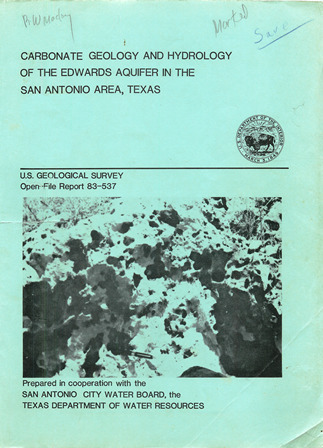Carbonate Geology and Hydrology of the Edwards Aquifer in the San Antonio Area, Texas

| Author | Maclay RW and Small TA |
| Year | 1984 |
| Description | Hydrostratigraphic subdivisions, types of rock, permeability and groundwater movement in the Edwards Aquifer in the San Antonio region |
| Report Number | USGS O-FR 83-537 |
| Publisher | US Geological Survey |
| Location | Edwards Aquifer, Balcones Fault Zone, San Antonio Segment |
| Cover | View Download |
| File | View Download |
| Summary |
|
Regional differences in the porosity and permeability of the Edwards aquifer are related to three major depositional areas, the Maverick basin the Devils River trend, and the San Marcos platform, that existed during Early Cretaceous time. The rocks of the Maverick basin are predominantly deep basinal deposits of dense, homogeneous mudstones of low primary porosity. Permeability is principally associated with cavernous voids in the upper part of the Salmon Peak Formation in the Maverick basin. The rocks of the Devils River trend are a complex of marine and supratidal deposits in the lower part and reefal or inter-reefal deposits in the upper part. Permeable zones, which occur in the upper part of the trend, are associated with collapse breccias and rudist reefs. The rocks of the San Marcos platform predominantly are micrites that locally contain collapse breccias, honeycombed, burrowed mudstones, and rudist reef deposits that are well leached and very permeable. The rocks of the San Marcos platform form the most transmissive part of the Edwards aquifer in the San Antonio area. Karstification of the rocks on the San Marcos platform during Cretaceous time enhanced the permeability of the aquifer. Permeability of the Edwards aquifer is greatest in particular strata (lithofacies) which have been leached in the freshwater zone. Ground water moves along vertical or steeply inclined fractures that are passageways by which water can enter permeable strata. Water moves from the fractures into beds formed by collapse breccias, burrowed wackestones, and rudist grainstones that have significant secondary porosity and permeability. Water has selectively dissolved sedimentary features within those rocks to increase the size of the openings and the degree of interconnection between pore voids. Recognition of the hydrostratigraphic subdivisions provides a basis for defining the nonhomogeneity of the aquifer and determining its storage characteristics. The aquifer is considered to be a faulted and multilayered aquifer in which lateral circulation is mainly through very permeable, hydrostratigraphic subdivisions that are hydraulically connected at places by openings associated with steep-angle, normal faults. The Edwards aquifer is vertically displaced for its entire thickness at places along major northeastward trending faults. At these places, ground-water circulation is diverted either southwest or northeast. |
Search for Documents
Advance Search
Explore EAA's Scientific Reports
- All Reports
- Weather Modification
- Geology
- Water Use and Conservation
- Geochemistry
- Water Resources Planning and Management
- Floods and Drought
- Water Quality
- Climatology
- Surface Water / Groundwater Relationship
- Biology
- Springs, Groundwater Discharge
- Archaeology
- RZ Protection
- Aquifer Levels
- Remote Sensing
- Precipitation
- Overview Studies
- Modeling
- Hydrology and Hydrogeology
- History
- Groundwater Recharge, Recharge Zone
- Groundwater Movement
- Geomorphology and Caves
